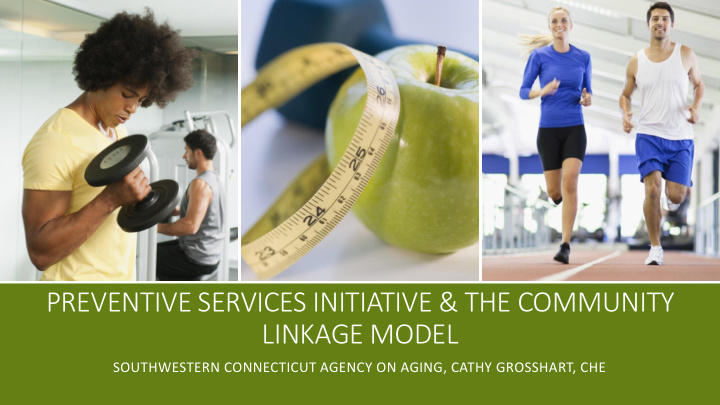



PREVENTIVE SERVICES INITIATIVE & THE COMMUNITY LINKAGE MODEL SOUTHWESTERN CONNECTICUT AGENCY ON AGING, CATHY GROSSHART, CHE
WHO WE ARE ▪ An Agency committed to the independence and dignity of older adults and persons with disabilities in Southwestern Connecticut ▪ A funder of community-based programs like Adult Day Centers and home-delivered meals in partnership with the Federal Administration of Community Living ▪ A contractor for the State of Connecticut helping over 3,000 people remain in their home as an alternative to nursing home care ▪ A leader in the aging & disability network helping individuals access and enroll in person-centered services and supports
IN INTERSECTION OF HEALTHCARE & & COMMUNITY- BASED SERVICES- THE LIN INKAGE MODEL ▪ Recognition of the importance of partnership between the healthcare sector and community-based organizations ▪ A team-based approach (healthcare & the community) to support patient goals and outcomes ▪ Understanding the connection between the patient and socio- economic, environmental and cognitive challenges ▪ Reducing and mitigating the non-health related challenges faced by the patient
WHAT WE DID ID OPTI TIMUS SWCA CAA ▪ Consulted with each referral ▪ Educate the clinical and CHW staff on the value of self ▪ Identify any social determinants or activation and self efficacy barriers that could interfere ▪ Identify a cohort of patients ▪ Minimize or remove the barrier, with trouble managing diabetes i.e. transportation, food insecurity ▪ Track baseline health metrics ▪ Encourage and motivate participant ▪ Refer clients to SWCAA ▪ Offer six-week, evidence based ▪ Follow up with patient health program
WHAT IS IS SELF EFFICACY OR SELF BELIEF Self efficacy is the belief we have in our own abilities, specifically our ability to meet the challenges ahead of us and complete a task successfully. (Bandura, 1977) ▪ Self efficacy helps us understand our role in our health outcomes ▪ Self efficacy helps us develop strategies to master tasks ▪ Self efficacy helps us stay interested and committed to our goals ▪ Self efficacy helps us rebound from setbacks & disappointments
THE LIN INE FROM SELF EFFICACY TO SELF MANAGEMENT ▪ Connects life priorities to health outcomes ▪ Enhances coping with emotions and/or depression ▪ Improves personal relationships ▪ Supports healthy lifestyle ▪ Enhances communication with clinicians ▪ Drives therapy adherence, medication compliance, etc.
EVIDENCE-BASED DIABETES SELF MANAGEMENT ▪ Evidence-based following strict research protocols from Stanford University ▪ Brings a cohort of up to 16 people together to form a bond and learn how they can help control their disease ▪ Meets for six weeks at a location accessible to community members ▪ Offers course in English or Spanish- Trained leaders ▪ Encourages patient activation, develops disease maintenance strategies and supports sustainable lifestyle changes
THE NUMBERS 137 82 registered participants referrals 47 attend at least one workshop session 37 attend at least three sessions.
AND THE SURVEY SAYS.. I have accomplished a lot and what I have learned I apply to my daily routine- all the I would love the class to go on information was very helpful. because we would be more educated A lot of weight lost, better way on how to deal with our illness. I to maintain my health, self really liked meeting everyone and knowledge and how to control sharing with new friends. my diabetes. I would not change anything. The teachers were very informative.
▪ True barriers exist that make participation difficult to impossible – the CBO must offer mitigation strategies ▪ The program works when the participant is referred and encouraged by the healthcare organization ▪ One-on-one encouragement helps get participants in the door LESSONS LEARNED ▪ Course completers are hungry for additional opportunities post workshop A true partnership between the ▪ A mix of self management and an opportunity to “ask Community-based Organization and the Healthcare the expert” (doctor, nurse, dietician) reinforces the Organization is needed to truly message support the patient in all settings and at all levels of ▪ Communication between the CBO and the HCO is activation. ESSENTIAL
Recommend
More recommend